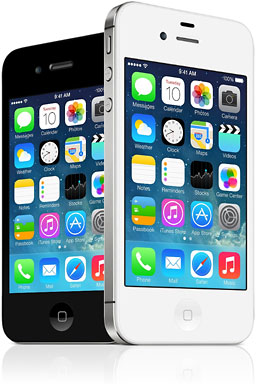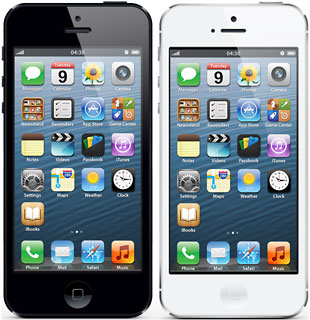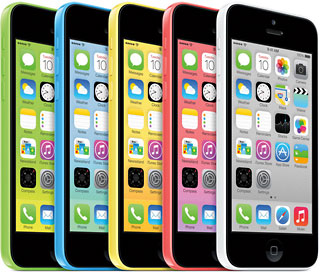Yes, Android is the top selling mobile platform around the world. Yes, Android dominates the low end of the smartphone and tablet markets. So why do you see so many iPhone and iPad cases and accessories when you go shopping?
Follow the Money
 First of all, it’s because Apple was the first dominant player in the touch screen smartphone market (not the touch-with-a-stylus screen, but touch with your finger). The iPhone changed the face of the smartphone market. People want to follow the leader!
First of all, it’s because Apple was the first dominant player in the touch screen smartphone market (not the touch-with-a-stylus screen, but touch with your finger). The iPhone changed the face of the smartphone market. People want to follow the leader!
Shoot, people were paying full price up front to buy the original iPhone, because Apple didn’t want to cheapen the brand by letting AT&T Wireless discount it to $299 or $399 with a two-year contract. Full price, as in $499 for the 4 GB version and $599 for the 8 GB iPhone. And it didn’t even have 3G connectivity!
Ah, but accessory makers smelled not only a growing market, but one with money. If you’re paying $500-600 for a phone, you’re going to want a nice case to protect it, and that’s where the accessory market begins. Then you get screen protectors, car chargers, and third-party USB cables with Apple’s dock connector. Oh, wait, those car chargers and dock cables already existed for the iPod – this was just a new market for an existing product.
A year later and we had the iPhone 3G. 3G connectivity – finally. And most iPhone accessories already worked with the iPhone 3G. Because it was nearly the same size and weight as the 2007 iPhone, there were some case revisions, but that’s about it.
And then, brilliantly, Apple released the iPhone 3GS. It looked exactly like the 3G, and the same cases fit it.
iPhone Design, Mark II
 In 2010, Apple redesigned the iPhone. The iPhone 4 had a flat back, not curved like previous models. And for the first time, there was a CDMA version of the iPhone, so Verizon and Sprint could sell it, not just AT&T. And that seductive Retina Display was to smartphones what HD television was compared to DVDs and older VGA-class TV displays.
In 2010, Apple redesigned the iPhone. The iPhone 4 had a flat back, not curved like previous models. And for the first time, there was a CDMA version of the iPhone, so Verizon and Sprint could sell it, not just AT&T. And that seductive Retina Display was to smartphones what HD television was compared to DVDs and older VGA-class TV displays.
The iPhone 3GS remained on as the entry-level iPhone, so accessory makers could unload the last of their 3G/3GS cases before the iPhone 3GS was discontinued.
In 2011, Apple released the iPhone 4S, and it was good. It used the same accessories as the iPhone 4, one model worked on GSM and CDMA networks, and it had a dual-core processor. Accessory makers leveraged their 2010 designs for another year.
iPhone Design, Mark III
 There really wasn’t anything wrong with the iPhone 4 design, but the market was choosing Android smartphones with larger displays. So Apple stretched the iPhone 4 design just a bit, making it 3/8″ larger in the long dimension while also making it 23% thinner and nearly an ounce lighter.
There really wasn’t anything wrong with the iPhone 4 design, but the market was choosing Android smartphones with larger displays. So Apple stretched the iPhone 4 design just a bit, making it 3/8″ larger in the long dimension while also making it 23% thinner and nearly an ounce lighter.
The iPhone 5 was a hit, and accessory makers knew they would be able to leverage their designs for two model years, just as they had with the 3G/3GS and 4/4S.
The iPhone 5 introduced the Lightning connector. Unlike the big dock connector inherited from the iPod era, you couldn’t plug in Lightning the wrong way. You couldn’t even try. It was an intelligent cable that just worked.
Apple also moved the headphone jack to the bottom of the iPhone. Between that and the Lightning port, there was a big market for adapters that would let the iPhone 5 work with old hardware – and a big market for new accessories designed for the new port configuration.
Lo and behold, the iPhone 5S looked just like the iPhone 5, but it added a 64-bit CPU and a fingerprint sensor. And everything was good in accessory-land.
iPhone 5C, Odd One Out
 I don’t think Apple will ever give us the full story behind the iPhone 5C, the one and only iPhone with a plastic case. The only iPhone model to date to ship with five different colors.
I don’t think Apple will ever give us the full story behind the iPhone 5C, the one and only iPhone with a plastic case. The only iPhone model to date to ship with five different colors.
The iPhone 5C takes the iPhone 5 insides and puts everything in a new case. There are two reasons for that.
First off, the iPhone 5 was known to bend a bit – or quite a bit – if you put it in your back pocket and sat on a hard surface. (“Buns of Steel” do have a downside…) It wasn’t a huge problem, but social media made it a well known problem. A thicker, more rugged case would fix that.
Batterygate
The other problem was that for about five months (through about February 2013), there were problems surrounding the battery in the iPhone 5. Apple says it was a defective battery and issued a recall, which only applied to the original owner and only through February 2016.
I suspect the problem wasn’t the battery per se. It holds a charge and functions as it should. The problem is that iOS 6 through 9.2 give very spurious reports on the charge in the battery. It can drop 20-30% in a flash. It can jump 10-20% simply by plugging in a charger. (I have one, and I have seen both happen.) Something is wrong here.
I don’t know the ins and outs of iPhones. If the iPhone has a smart battery, the circuitry in the battery could be the problem. Or the problem is with the circuitry on the iPhone 5’s original system board that is problematic. Since the spurious energy level reports persist after you replace the battery with a third-party battery, my guess is that the problem is on the logic board.
As further evidence, Apple didn’t recall the iPhone 5 so you could bring it to the Apple retail store and have a new battery installed. No, you had to back up your iPhone 5 to your computer, wipe it, and then bring it to Apple for a replacement unit. One made after February 2013, which I suspect means one where whatever circuitry was causing problems in the early iPhone 5 no longer existed.
This is an educated guess, and based on talks with the guys at Genius Phone Repair, I think it’s on target. They tell me that of all the iPhone models ever made, the iPhone 5 is the one most likely to have its battery replaced.
Several of us iPhone 5 users have noticed that we are seeing better battery life and loss odd changes in power level since iOS 9.3 or thereabout. Since this could be the last major iOS version – or perhaps next to last – for the iPhone 5, it’s nice to see this fixed before Apple leaves the iPhone 5 behind.
iPhone Design, Mark IV and IV Plus

Apple finally caught on that the market had shifted to larger screens, and in 2014 it answered that with two new designs. The iPhone 6 with its 4.7″ display and the 6 Plus with its 5.5″ screen. And in 2015, it recycled the design for the next generation of iPhones. And accessory makers rejoiced.
Surprise, iPhone Design Mark III Is Back
 And then Apple surprised us by discontinuing the iPhone 5S at the end of March 2016. Apple had never released a new iPhone in spring. Besides, most people believed that the small iPhone was going to become history when the 2016 “iPhone 7” came out.
And then Apple surprised us by discontinuing the iPhone 5S at the end of March 2016. Apple had never released a new iPhone in spring. Besides, most people believed that the small iPhone was going to become history when the 2016 “iPhone 7” came out.
Nope, Apple released the new iPhone SE, and it was exactly the same size as the iPhone 5 and 5S had been. All those cases and other accessories specific to the iPhone 5 – in many cases already being shipped back due to the impending end of the iPhone 5S later in the year – had a new lease on life.
Okay, What About Android?
The point of all this is that when Apple comes up with a good design, it sticks with it. Looking at Apple II, Mac, and iPod history, we see Apple reusing a good product design and leaving very few orphans behind. The Apple IIGS was a one-shot design. So was the Mac IIsi. And don’t forget the 20th Anniversary Mac and the Power Mac G4 Cube, but there are very few exceptions to Apple’s rule of getting what life it can out of good product design.
In the world of iPods and iPhones and iPads, that means accessory makers know they can sell a product for several years. Apple isn’t going to come up with a new design in a year or six months that leaves a recently introduced design behind.
In the Android world, not so much. If you can make it slimmer or give it a bigger screen or move a button or change the camera’s location or . . . you get the picture. Not only are there innumerable Android designs out there, accessory makers have no idea how long a new design might last, so they focus only on the most popular models.
And What About the ‘iPhone 7’?
Low End Mac is not a rumor site, and I’m not going to regurgitate some of the stuff that’s making the rounds as rumor when much if it is idle speculation. Apple may introduce a new design for the “iPhone 7”. It may (or may not) have a headphone jack. It may be thinner. It may be bigger. It may introduce a new naming scheme, as the iPhone SE did earlier this year.
I think Apple would be foolish to discontinue the headphone jack. So many devices with docks for modern iPhones (ones with Lightning and the headphone jack on the bottom) would not work without a headphone jack.
That said, if Apple is going to make a change, let’s go all the way and move the iPhone to USB-C and get rid of this proprietary Lightning nonsense. I know I’m tired of inexpensive third-party Lightning charge cables that don’t last. An industry standard port would be a nice step in the right direction.
Whatever, I’m not going to get bent out of shape over something Apple hasn’t officially announced. I’d like to see Apple modify the iPhone 6/6 Plus design because I’ve read that its rounded edges make it too easy to drop, but Apple will do whatever it thinks is best.
And if there is a new design, expect it to be used for at least two model years.
Keywords: #iphonedesign
Short link: http://goo.gl/v0HZkj

